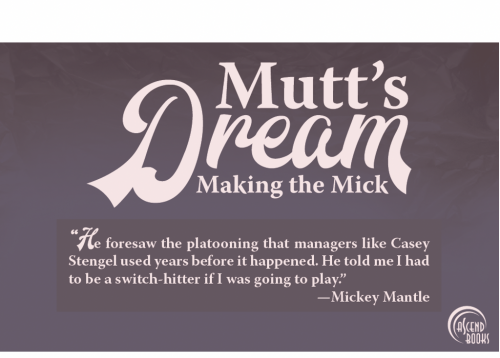Off The Bookshelf: Mutt’s Dream: Making The Mick September 13
By Andy Esposito, courtesy of NY Sports Day
https://www.nysportsday.com/2020/09/13/off-the-bookshelf-mutts-dream-making-the-mick/
Someday, when some film maker chronicles the life of Mickey Mantle, and surely the career of one of baseball’s greatest and most popular players – ever – is deserving of a robust cinematic treatment, and not just as a secondary figure as portrayed in Billy Crystal’s, “61!” – the producers will, no doubt, research a new book by Howard Burman, “Mutt’s Dream: Making The Mick,” as the basis for scripting the Yankee icon’s boyhood years growing up in Oklahoma.
What makes a man, what makes a ballplayer, what is the foundation from which grows an icon is the atom of this treatment, richly detailed to where you might feel you are already holding the screenplay to document.
“Mutt’s Dream: Making the Mick” (Ascend Books, hardcover, 320 pp, $22.95) is not a rehash of Mantle’s Hall of Fame career, his 536 home runs, his many moments in many World Series, his MVPs and other honors. No, it actually ends just as he’s starting to make his mark in the minor leagues.
Every baseball fan, and certainly every Yankees fan, however, will thoroughly enjoy the journey and relate to the hardships of this charismatic character from even before his birth to the time he signs with Yankees scout Tom Greenwade.
You could make a case that Mickey Charles Mantle – so named in honor of Philadelphia Athletics catcher Mickey Cochrane – is at or near the very top of a most prestigious list of most popular ballplayers ever, even to this day. Some 25 years since he passed away, and over 50 years since he played his last game, Mantle’s fans still resonate in the multi-millions (this observer among them), with No. 7 Yankees jerseys ever-present at every game (ahem, when fans are allowed back in the stands).
Why? Why Mantle arguably more so than even Babe Ruth? Joe DiMaggio? Or legends such as Hank Aaron, Willie Mays, or even Jackie Robinson?
All great players, all icons, and still immensely popular, and so socially important, but Mantle came upon a baseball-craving public just as television was blossoming, and although all of the aforementioned were also big winners, Mantle was in the World Series all the time, and on the Game of the Week seemingly all the time, and for a long, long, time, which served as the roots of his popularity.
And he had that name, that alliteration affectation that rolled off the tongue, Mickey Mantle.
Mickey was never a Michael. His dad, Elven “Mutt” Mantle, was such a St. Louis Cardinals fan in Spavinaw, Oklahoma (the closest major league team to his Dust Bowl upbringing, and could track their games by radio), but he just had to name his first son after his favorite player, the future Hall of Famer who played with the Athletics and Tigers from 1925-37.
“Mutt imagines himself as another Cochrane,” writes Burman. Mutt liked to think, “He’s just like me.”
The 1930 World Series between the Cardinals and Athletics was a soup of mixed emotions as Mutt followed each game on his Philco.
Mutt was such a Cochrane fan that he wanted Mickey to be a catcher, and trained him as such, literally as soon as he could walk. From the womb, Mutt knew he was raising a ballplayer, but Mickey Mantle, a catcher?
Doesn’t seem right in retrospect, but sure enough, the first time the young Mickey took to a ballfield, it was behind the plate.
Of course Mantle grew to become a good ballplayer. His natural talents led him to being a star pitcher and shortstop who could hit a “country mile.”
Mantle also could naturally play well on a basketball court, and to be with his friends, he also wanted to play football.
At first, Mutt said, “No!” No football, too dangerous to get injured and ruin the baseball career was his thinking. He said no again and again, but eventually gave in to his son’s wishes.
Perhaps he should have stuck to his principles.
Mantle was equally adept on the gridiron, but there was a game where he was kicked in the left shin, which became infected and led to a nearly two-week hospital stay. Doctors actually seriously considered amputating his left leg below the knee (history is grateful that procedure never occurred).
And it is at least possible Mantle’s life-long bouts with leg problems may have been born with that kick to the shin.
“Mutt’s Dream” is replete with such moments that gave root to the Mantle personna, including to his relationships with women, which may have been influenced by a form of abuse by a female relative when he was very, very young.
But what stands out most about “Mutt’s Dream” is the dialogue, lengthy passages of dialogue from some 80 years ago or so that can make you question its validity. As if the proverbial fly on the wall back then somehow recorded those moments and beamed them to the present with infinite precision.
Burman does admit to “inventing” some of the dialogue, as he is an accomplished playwright, “but never in contradiction to what we know to be factual or at least reported to be factual.”
And “always as a reflection of the reality of the situation.”
The author culled some of the dialogue from a litany of sources, including the many bios on Mantle, Oklahoma newspaper accounts, Mantle’s Commerce High School Yearbook, the Oklahoma Historical Society, the National Baseball Hall of Fame, the Baylor University Medical Center where Mantle passed away in 1995, and indeed, the Mantle family and some of his oldest friends.
Truly well-researched, none of the “fictitious” dialogue or moments detracts from enjoying the book, and as noted, it reads like episodes of a great television series. Call Netflix. Call Amazon Prime. Time to cast “Mutt’s Dream” as soon as the studios are back up and running.

